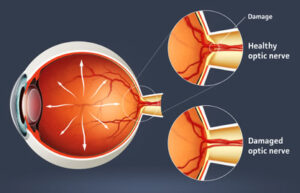GLAUCOMA

Don’t lose sight! Trust your eyes to the best. Dr. Krishnan is Corpus Christi’s only Fellowship Trained Glaucoma specialist.
GLAUCOMA: TYPES, SYMPTOMS, DIAGNOSIS AND TREATMENT
Glaucoma is a group of related eye disorders that cause damage to the optic nerve that carries information from the eye to the brain.
In its early stages, glaucoma usually has no symptoms, which is what makes it so dangerous — by the time you notice problems with your sight, the disease has progressed to the point that irreversible vision loss has already occurred and additional loss may be difficult to stop.
In most cases, glaucoma is associated with higher-than-normal pressure inside the eye — a condition called ocular hypertension. But it also can occur when intraocular pressure (IOP) is normal. If untreated or uncontrolled, glaucoma first causes peripheral vision loss and eventually can lead to blindness.
According to the American Academy of Ophthalmology, the most common type of glaucoma — called primary open-angle glaucoma — affects an estimated 2.2 million people in the United States, and that number is expected to increase to 3.3 million by 2020 as the U.S. population ages.

And because most cases of glaucoma have few or no early symptoms, about half of Americans with glaucoma don’t know they have it.
In most types of glaucoma, elevated intraocular pressure (IOP) is associated with damage to the optic nerve in the back of the eye.
Glaucoma is the second-leading cause of blindness in the U.S. (behind macular degeneration), and the second-leading cause of blindness worldwide (behind cataracts).
TYPES OF GLAUCOMA
The two major categories of glaucoma are open-angle glaucoma (OAG) and narrow-angle glaucoma. The “angle” in both cases refers to the drainage angle inside the eye that controls the outflow of the watery fluid (aqueous) that is continually being produced inside the eye.
If the aqueous can access the drainage angle, the glaucoma is known as open-angle glaucoma. If the drainage angle is blocked and the aqueous cannot reach it, the glaucoma is known as narrow-angle glaucoma.
Variations of OAG include primary open-angle glaucoma (POAG), normal-tension glaucoma (NTG), pigmentary glaucoma, pseudoexfoliation glaucoma, secondary glaucoma, and congenital glaucoma.
Variations of narrow-angle glaucoma include acute angle-closure glaucoma, chronic angle-closure glaucoma, and neovascular glaucoma.
DIAGNOSIS, SCREENING AND TESTS FOR GLAUCOMA
During routine eye exams, a tonometer is used to measure your intraocular pressure, or IOP. Your eye typically is numbed with eye drops, and a small probe gently rests against your eye’s surface.
An abnormally high IOP reading indicates a problem with the amount of fluid (aqueous humor) in the eye. Either the eye is producing too much fluid, or it’s not draining properly.
Other methods of monitoring glaucoma involve the use of sophisticated imaging technology — such as scanning laser polarimetry (SLP), optical coherence tomography (OCT) and confocal scanning laser ophthalmoscopy — to create baseline images and measurements of the eye’s optic nerve and internal structures.
GLAUCOMA TREATMENTS
Treatment can involve glaucoma surgery, lasers or medication, depending on the severity. Eye drops with medication aimed at lowering IOP usually are tried first to control glaucoma.
Because glaucoma often is painless, people may become careless about the strict use of eye drops that can control eye pressure and help prevent permanent eye damage.
In fact, non-compliance with a program of prescribed glaucoma medication is a major reason for blindness caused by glaucoma.
If you find that the eye drops you are using for glaucoma are uncomfortable or inconvenient, never discontinue them without first consulting your eye doctor about a possible alternative therapy.
